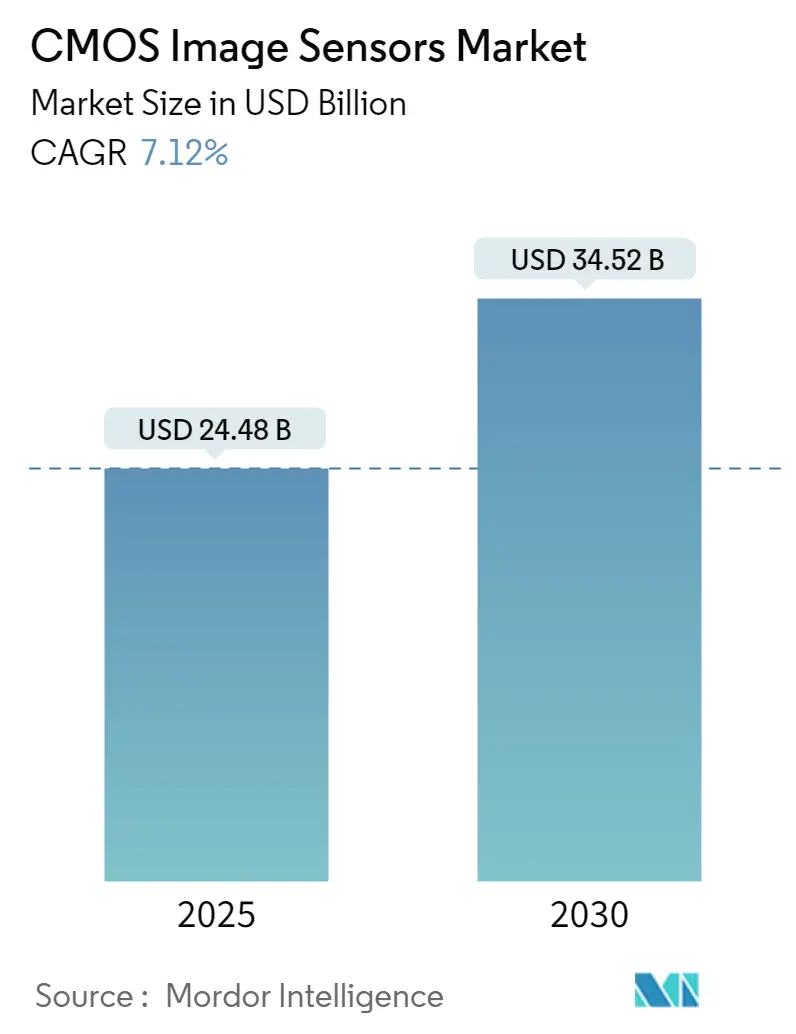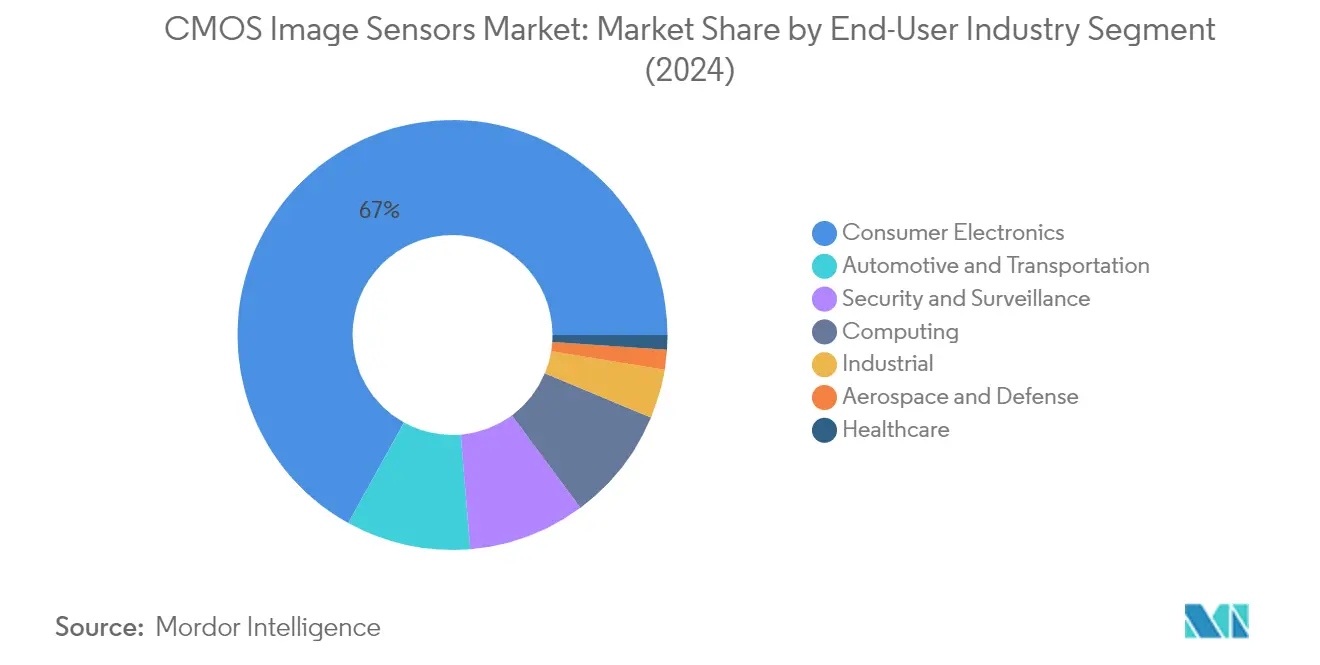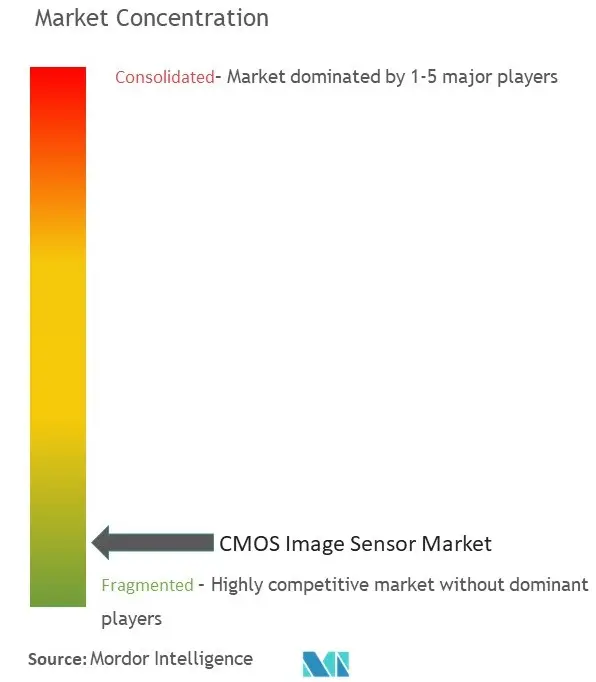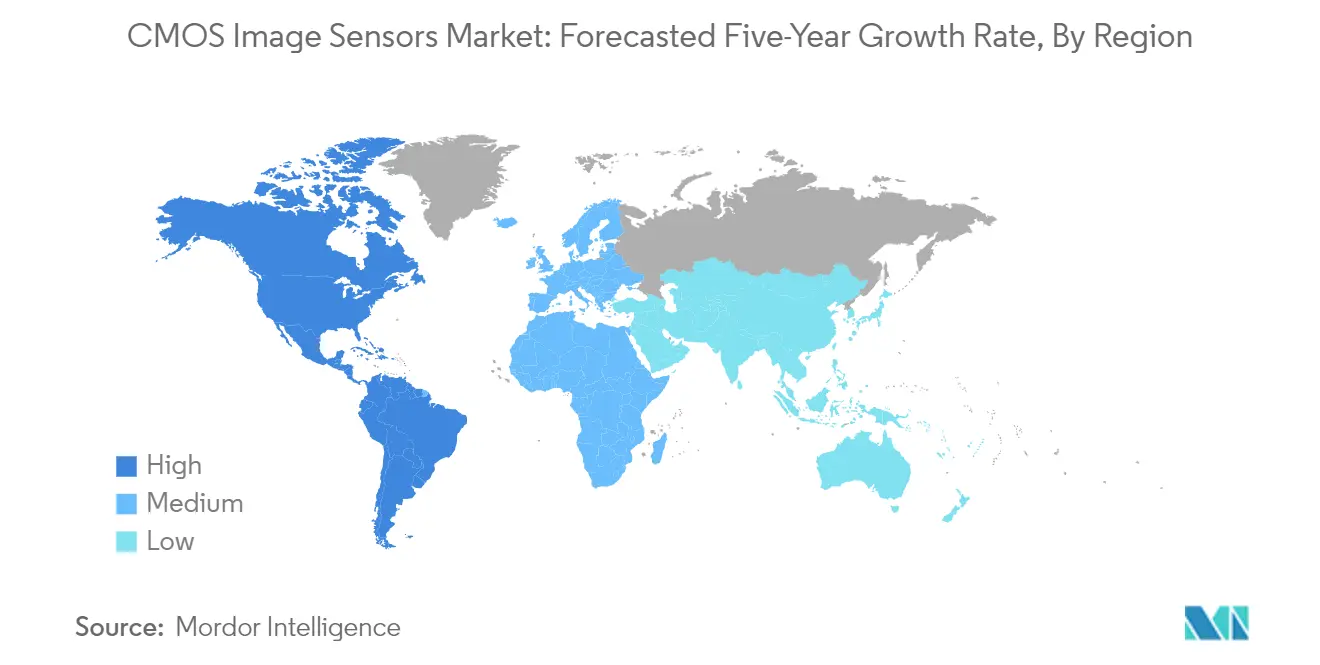
CMOS Image Sensors Market Analysis
The CMOS Image Sensors Market size is estimated at USD 24.48 billion in 2025, and is expected to reach USD 34.52 billion by 2030, at a CAGR of 7.12% during the forecast period (2025-2030).
The CMOS image sensor industry is experiencing transformative changes driven by technological advancement and sustainability initiatives. The automotive sector's evolution towards electric and autonomous vehicles has become a significant catalyst, with the International Energy Agency reporting that road transport accounts for over 15% of global energy-related emissions. This transition is reflected in the IEA's projection that electric vehicles will constitute 18% of new car sales in 2023, with major markets like Europe, China, and the United States leading this transformation. The integration of sophisticated imaging systems in these vehicles has become crucial for ensuring safety and advancing autonomous capabilities, particularly through the use of automotive image sensors.
The regulatory landscape and institutional support are shaping market dynamics significantly. In a notable development, the Federal Transit Administration recently announced funding opportunities worth USD 6.5 million for ADAS demonstration projects, including USD 5 million specifically for Transit Buses. The United Kingdom's approval of Ford's BlueCruise hands-free driving technology in April 2023 marks another significant milestone in ADAS adoption. These initiatives align with the National Safety Council's projection that by 2026, approximately 71% of registered vehicles will feature rear cameras, a key component of the automotive camera sensor market.
Manufacturing innovation and regional expansion are reshaping the industry's landscape. A significant development occurred in October 2023 when HMD Global became the first major smartphone company to manufacture devices in Europe with its Hungarian 5G model launch. This shift in manufacturing geography demonstrates the industry's response to growing demands for supply chain diversification and regional self-sufficiency. The trend is further exemplified by major manufacturers' continuous product innovations, such as Sony's September 2023 launch of the IMX735 camera sensor for automotive cameras, featuring the industry's highest pixel count at 17.42 effective megapixels.
The World Economic Forum's projection of annual sales reaching 12 million fully autonomous vehicles by 2035, representing 25% of the global automotive market, underscores the long-term growth trajectory. This forecast has catalyzed significant investments in research and development, particularly in advanced imaging technologies. The industry is witnessing a surge in product innovations aimed at meeting the increasingly sophisticated requirements of autonomous systems, with manufacturers focusing on developing sensors that can operate effectively in diverse environmental conditions while maintaining high performance and reliability standards.
CMOS Image Sensors Market Trends
Growing Implementation of CMOS Image Sensors in the Consumer Electronics Segment
The consumer electronics segment has emerged as a primary growth driver for the CMOS image sensor market, particularly driven by the smartphone industry's evolution. The integration of multiple cameras in smartphones has become standard, with manufacturers incorporating up to five cameras in a single device to meet the growing demands of mobile photography enthusiasts. This trend is evidenced by significant product launches, such as SmartSens' introduction of the 50MP ultra-high resolution 1.0μm pixel size image sensor "SC550XS" in March 2022, which integrates multiple proprietary technologies including SmartClarity-2, SFCPixel, and PixGain HDR technology.
The expansion of 5G technology and the introduction of new products with advanced features continue to fuel the adoption of smartphones, tablets, and DSLR cameras. According to GSMA, Latin America entered the 5G era with 15 million connections expected by 2022, with projections indicating that 5G will account for 12% of the region's total connections by 2025. The market is also witnessing significant developments in mixed reality headsets, exemplified by Apple's introduction of Vision Pro in June 2023, featuring a 3D camera for capturing spatial photos and videos. This diversification of applications, coupled with continuous technological improvements in CMOS technology, has resulted in cameras that produce high-quality images at faster speeds, driving increased adoption across various consumer electronic devices.
Emergence of 4K Pixel Technology in the Security and Surveillance Sector
The security and surveillance sector is experiencing a revolutionary transformation with the integration of 4K pixel technology in CMOS image sensors. Digital surveillance cameras equipped with this technology offer superior high-definition clarity and wider viewing angles, enabling businesses to monitor their facilities with unprecedented detail. The advancement is particularly evident in Sony's newest image sensor featuring STARVIS 2 technology, specifically developed for security cameras, allowing for more explicit images in low-light environments and enhancing overall surveillance capabilities.
The adoption of 4K pixel technology in security applications has demonstrated significant cost benefits through reduced total ownership costs compared to lower-resolution cameras. This technology has found extensive applications in various settings, from city surveillance to traffic monitoring, with notable implementations such as Delhi's investment of INR 264 crore in installing 1.32 lakh CCTV cameras across the national capital. The technology's capabilities extend beyond traditional security applications, proving valuable in license plate recognition from considerable distances and monitoring large areas effectively. Recent developments include Idis's launch of new edge AI cameras in February 2023, featuring 5MP dome and bullet models integrated with the Idis Deep Learning Engine, demonstrating the ongoing evolution and enhancement of surveillance technology through the integration of artificial intelligence with high-resolution imaging capabilities.
Segment Analysis: By End-User Industry
Consumer Electronics Segment in CMOS Image Sensors Market
The consumer electronics segment dominates the CMOS image sensors market, commanding approximately 67% market share in 2024. This dominance is primarily driven by the increasing integration of advanced mobile camera sensor technologies in smartphones, tablets, and digital cameras. The segment's growth is significantly influenced by the rising demand for high-resolution smartphone camera sensor capabilities, with manufacturers continuously introducing devices featuring multiple camera setups. The proliferation of mixed reality headsets, action cameras, and the growing trend of social media content creation has further strengthened this segment's position. Major smartphone manufacturers are increasingly focusing on enhancing camera capabilities through advanced CMOS image sensors, particularly in premium devices, while the expanding market for smart wearables and portable devices continues to create new opportunities for digital camera sensor applications.

Automotive and Transportation Segment in CMOS Image Sensors Market
The automotive and transportation segment is emerging as the fastest-growing sector in the automotive image sensors market, with an expected growth rate of approximately 11% during 2024-2029. This remarkable growth is primarily attributed to the increasing adoption of advanced driver-assistance systems (ADAS) and the development of autonomous vehicles. The integration of multiple cameras for applications such as parking assistance, lane departure warning, and collision avoidance systems is becoming standard in modern vehicles. The segment's growth is further accelerated by stringent safety regulations worldwide and the increasing consumer demand for vehicles equipped with advanced safety features. The emergence of electric vehicles and the continuous innovation in automotive camera technologies are creating additional opportunities for CMOS image sensor implementations in this sector.
Remaining Segments in CMOS Image Sensors Market
The CMOS image sensors market encompasses several other significant segments, including security and surveillance, computing, industrial, healthcare, and aerospace and defense. The security camera sensor and surveillance camera sensor segment is experiencing substantial growth due to increasing public safety concerns and smart city initiatives. The computing segment maintains its importance through the integration of high-quality cameras in laptops and tablets, while the industrial segment is driven by machine vision sensor applications and quality control systems. The healthcare segment is witnessing increased adoption in medical imaging devices and diagnostic equipment, while the aerospace and defense sector utilizes these sensors for various military and surveillance applications. Each of these segments contributes uniquely to the market's diversity and overall growth trajectory.
CMOS Image Sensors Market Geography Segment Analysis
CMOS Image Sensors Market in the Americas
The Americas region represents a significant portion of the global image sensors market, holding approximately 25% of the CMOS image sensor market share in 2024. The region's dominance is primarily driven by the strong presence of the consumer electronics market and the increasing adoption of advanced driver-assistance systems (ADAS) in the automotive sector. The market is characterized by substantial investments in research and development, particularly in emerging technologies like artificial intelligence and machine vision systems. The presence of major technology companies and semiconductor manufacturers has created a robust ecosystem for innovation in image sensor technology. The healthcare sector's growing demand for advanced imaging solutions, coupled with the increasing adoption of surveillance systems across various industries, continues to drive market growth. Furthermore, the region's strong focus on industrial automation and robotics applications has created additional demand for high-performance image sensors. The Americas market also benefits from the increasing integration of CMOS sensors in smartphones, tablets, and other consumer electronic devices, particularly with the rising demand for high-quality camera features.
CMOS Image Sensors Market in Europe
The European CMOS market has demonstrated robust growth, with an approximate growth rate of 6% from 2019 to 2024. The region's market is primarily driven by the strong presence of automotive manufacturers and their increasing focus on implementing advanced driver assistance systems. The market landscape is characterized by significant investments in research and development, particularly in emerging applications such as machine vision and industrial automation. Europe's stringent safety regulations and quality standards have fostered the adoption of advanced imaging solutions across various industries. The region's strong focus on industrial digitization and Industry 4.0 initiatives has created substantial opportunities for CMOS image sensor market growth in manufacturing and quality control processes. Additionally, the growing adoption of surveillance systems and security cameras, particularly in urban areas and transportation hubs, has contributed to market expansion. The healthcare sector's digital transformation and the increasing adoption of advanced medical imaging technologies have further strengthened market growth in the region.
CMOS Image Sensors Market in Japan
The Japanese CMOS market is projected to grow at approximately 5% during the forecast period 2024-2029. Japan maintains its position as a global leader in image sensor technology, driven by the presence of major manufacturers and continuous technological innovations. The market is characterized by significant investments in research and development, focusing on next-generation sensor technologies and advanced manufacturing processes. Japanese companies have established themselves as key players in developing high-performance sensors for smartphones, automotive applications, and industrial systems. The country's strong manufacturing capabilities and expertise in semiconductor technology continue to drive innovation in the sector. The market benefits from the growing adoption of automation and robotics in manufacturing, creating sustained demand for advanced imaging solutions. Additionally, Japan's focus on developing cutting-edge technologies for autonomous vehicles and advanced driver assistance systems has created new opportunities for image sensor applications. The integration of artificial intelligence and machine learning capabilities in imaging systems has further expanded the market potential.
CMOS Image Sensors Market in China
China represents a crucial market in the global image sensor market size landscape, driven by its massive consumer electronics manufacturing sector and growing technological capabilities. The country's robust smartphone manufacturing ecosystem and increasing domestic demand for high-quality imaging solutions have created substantial market opportunities. China's strategic focus on developing its semiconductor industry has led to significant investments in image sensor technology and manufacturing capabilities. The market is characterized by strong government support for technological innovation and domestic production capabilities. The rapid adoption of advanced driver assistance systems in the automotive sector and the growing implementation of surveillance systems have created additional demand streams. Furthermore, China's push towards industrial automation and smart manufacturing has increased the demand for machine vision systems and industrial cameras. The market also benefits from the country's growing focus on artificial intelligence and IoT applications, which require advanced imaging capabilities.
CMOS Image Sensors Market in the Rest of the World
The Rest of the World market for CMOS image sensors encompasses diverse regions including Asia-Pacific (excluding China and Japan), the Middle East, and Africa, each presenting unique growth opportunities. These regions are experiencing increasing adoption of CMOS image sensors driven by the growing smartphone penetration and rising demand for advanced surveillance systems. The market is characterized by significant investments in manufacturing capabilities, particularly in countries like India and South Korea, which are emerging as important electronics manufacturing hubs. The automotive sector's growth in these regions, coupled with increasing implementation of advanced driver assistance systems, has created new opportunities for image sensor applications. The healthcare sector's digital transformation and the adoption of advanced medical imaging technologies have further expanded the market scope. Additionally, government initiatives supporting electronics manufacturing and digital transformation have created favorable conditions for market growth. The increasing focus on smart city projects and security applications has also contributed to the rising demand for CMOS image sensors in these regions.
CMOS Image Sensors Market Overview
Top Companies in CMOS Image Sensors Market
The CMOS image sensor manufacturers market is characterized by intense innovation and strategic developments among key players, including Sony Corporation, Samsung Electronics, Omnivision Technologies, STMicroelectronics, and ON Semiconductor. These image sensor manufacturers are focusing on developing advanced sensor technologies like backside illumination (BSI), global shutter capabilities, and enhanced pixel architectures to meet evolving application demands. Operational agility is demonstrated through flexible manufacturing capabilities and robust supply chain management, allowing quick responses to market changes and customer requirements. Strategic moves in the industry include significant investments in R&D facilities, expansion of production capacities, and development of application-specific solutions for the automotive, healthcare, and industrial sectors. Market leaders are also pursuing vertical integration strategies, controlling everything from design to manufacturing, while establishing strategic partnerships with OEMs and technology providers to strengthen their market position.
Consolidated Market with Strong Asian Leadership
The CMOS image sensor market exhibits a highly consolidated structure dominated by large Asian conglomerates, particularly from Japan and South Korea, who leverage their technological expertise and manufacturing capabilities. These market leaders benefit from economies of scale, established relationships with major smartphone and consumer electronics manufacturers, and extensive intellectual property portfolios. The market shows significant barriers to entry due to high capital requirements, complex manufacturing processes, and the need for advanced technological capabilities, which has led to the dominance of well-established players.
The industry has witnessed strategic mergers and acquisitions aimed at expanding technological capabilities and market reach, particularly in emerging applications like autonomous vehicles and IoT devices. Companies are increasingly focusing on acquiring specialized technology firms to enhance their product portfolios and gain access to new market segments. Regional players, especially from China, are emerging as significant contenders through government support and strategic investments in manufacturing capabilities, gradually challenging the established market structure.
Innovation and Diversification Drive Future Success
For incumbent camera sensor manufacturers to maintain and expand their market share, continuous investment in technological innovation and manufacturing capabilities remains crucial. Companies need to focus on developing specialized solutions for emerging applications while maintaining cost competitiveness through efficient production processes. The ability to offer customized solutions for specific end-user requirements, particularly in automotive and industrial applications, will be a key differentiator. Additionally, establishing strong partnerships with end-users and maintaining robust supply chain relationships will be essential for long-term success.
New entrants and challenger companies can gain ground by focusing on niche applications and emerging market segments where established players may have less presence. Success factors include developing innovative technologies that address specific market needs, establishing strategic partnerships with regional players, and leveraging government support programs. The regulatory landscape, particularly regarding environmental standards and safety requirements in automotive applications, will increasingly influence market dynamics. Companies must also address the growing emphasis on sustainable manufacturing practices and product lifecycle management to maintain a competitive advantage in the evolving market landscape.
CMOS Image Sensors Market Leaders
-
STMicroelectronics NV
-
Sony Group Corporation
-
Samsung Electronics Co. Ltd
-
ON Semiconductor Corporation
-
Canon Inc.
- *Disclaimer: Major Players sorted in no particular order

CMOS Image Sensors Market News
- March 2023: Onsemi announced the launch of a new, innovative image sensor – the AR0822. The device features an embedded High Dynamic Range (HDR) and optimized near-infrared response, necessary for applications in harsh lighting conditions such as security and surveillance, body cameras, doorbell cameras, and robotics. The sensor’s low-power architecture and Wake-on-Motion features are designed to significantly reduce system power consumption. The AR0822 is an 8-megapixel stacked 1/1.8-inch (8.81mm diagonal) back-side illuminated CMOS digital image sensor based on a 2.0 µm pixel. It boasts an active-pixel array of 3840 (H) x 2160 (V) and can capture 4K video at 60 frames-per-second, offering image capture in either linear or eHDR modes (120 dB) with a rolling-shutter readout.
- January 2023: Canon Inc. announced the development of a 1.0-inch, back-illuminated stacked CMOS sensor for monitoring applications. This sensor achieves an effective pixel count of approximately 12.6 million pixels (4,152 x 3,024) and provides a dynamic range of 148 decibels. Notably, the new sensor divides the image into 736 areas and autonomously determines the best exposure settings for each area.
CMOS Image Sensors Market Report - Table of Contents
1. INTRODUCTION
- 1.1 Study Assumptions and Market Definition
- 1.2 Scope of the Study
2. RESEARCH METHODOLOGY
3. EXECUTIVE SUMMARY
4. MARKET INSIGHTS
- 4.1 Market Overview
- 4.2 Industry Value Chain Analysis
-
4.3 Industry Attractiveness - Porter's Five Forces Analysis
- 4.3.1 Bargaining Power of Suppliers
- 4.3.2 Bargaining Power of Buyers
- 4.3.3 Threat of New Entrants
- 4.3.4 Threat of Substitute Products
- 4.3.5 Intensity of Competitive Rivalry
- 4.4 Assessment of the Impact of COVID-19 on the Industry
5. MARKET DYNAMICS
-
5.1 Market Drivers
- 5.1.1 Growing Implementation of CMOS Image Sensors in the Consumer Electronics Segment
- 5.1.2 Emergence of 4K Pixel Technology in the Security and Surveillance Sector
-
5.2 Market Restraints
- 5.2.1 Competition from CCD Sensor
6. TECHNOLOGY SNAPSHOT
-
6.1 By Communication Type
- 6.1.1 Wired
- 6.1.2 Wireless
7. MARKET SEGMENTATION
-
7.1 By End-user Industry
- 7.1.1 Consumer Electronics
- 7.1.2 Healthcare
- 7.1.3 Industrial
- 7.1.4 Security and Surveillance
- 7.1.5 Automotive and Transportation
- 7.1.6 Aerospace and Defense
- 7.1.7 Computing
-
7.2 By Geography
- 7.2.1 North America
- 7.2.2 Europe
- 7.2.3 Asia-Pacific
- 7.2.4 Latin America
- 7.2.5 Middle East and Africa
8. COMPETITIVE LANDSCAPE
-
8.1 Company Profiles
- 8.1.1 STMicroelectronics NV
- 8.1.2 Sony Corporation
- 8.1.3 Samsung Electronics Co. Ltd
- 8.1.4 ON Semiconductor Corporation
- 8.1.5 Canon Inc.
- 8.1.6 SK Hynix Inc.
- 8.1.7 Omnivision Technologies Inc.
- 8.1.8 Hamamatsu Photonics KK
- 8.1.9 Panasonic Corporation
- 8.1.10 Teledyne Technologies Inc.
- 8.1.11 GalaxyCore Shanghai Limited Corporation
- *List Not Exhaustive
- 8.2 Vendor Market Share Analysis
9. INVESTMENT ANALYSIS
10. MARKET OPPORTUNITIES AND FUTURE TRENDS
CMOS Image Sensors Market Industry Segmentation
A complementary metal-oxide-semiconductor(CMOS) image sensor is an optical technology used in machine vision for robots in OCR (optical character recognition) that can enhance satellite photographs and radar images. It is also used in digital cameras, CCTV cameras, and barcode readers.
The report's scope encompasses market sizing and forecast for communication type, end-user industry, and geography segments. By communication type, the market is segmented into wired and wireless. By end-user industry, the market is segmented into consumer electronics, healthcare, industrial, security and surveillance, automotive and transportation, aerospace and defense, and computing. By geography, the market is segmented into North America, Europe, Asia Pacific, Latin America, the Middle East, and Africa.
The report offers market forecasts and size in volume (units) and value (USD) for all the above segments.
| By End-user Industry | Consumer Electronics |
| Healthcare | |
| Industrial | |
| Security and Surveillance | |
| Automotive and Transportation | |
| Aerospace and Defense | |
| Computing | |
| By Geography | North America |
| Europe | |
| Asia-Pacific | |
| Latin America | |
| Middle East and Africa |
CMOS Image Sensors Market Research FAQs
How big is the CMOS Image Sensors Market?
The CMOS Image Sensors Market size is expected to reach USD 24.48 billion in 2025 and grow at a CAGR of 7.12% to reach USD 34.52 billion by 2030.
What is the current CMOS Image Sensors Market size?
In 2025, the CMOS Image Sensors Market size is expected to reach USD 24.48 billion.
Who are the key players in CMOS Image Sensors Market?
STMicroelectronics NV, Sony Group Corporation, Samsung Electronics Co. Ltd, ON Semiconductor Corporation and Canon Inc. are the major companies operating in the CMOS Image Sensors Market.
Which is the fastest growing region in CMOS Image Sensors Market?
Asia Pacific is estimated to grow at the highest CAGR over the forecast period (2025-2030).
Which region has the biggest share in CMOS Image Sensors Market?
In 2025, the Asia-Pacific accounts for the largest market share in CMOS Image Sensors Market.
What years does this CMOS Image Sensors Market cover, and what was the market size in 2024?
In 2024, the CMOS Image Sensors Market size was estimated at USD 22.74 billion. The report covers the CMOS Image Sensors Market historical market size for years: 2019, 2020, 2021, 2022, 2023 and 2024. The report also forecasts the CMOS Image Sensors Market size for years: 2025, 2026, 2027, 2028, 2029 and 2030.
Our Best Selling Reports
CMOS Image Sensors Market Research
Mordor Intelligence provides comprehensive market analysis and industry research for the cmos image sensor market, offering detailed insights into market dynamics, competitive landscapes, and emerging trends. Our industry reports cover extensive market data, including image sensor market size, cmos market share, and growth projections for various segments like automotive image sensors, mobile camera sensors, and vision sensors. The report, available as an easy-to-download report PDF, includes in-depth analysis of key image sensor manufacturers and their strategic initiatives, technological innovations in optical sensors, and regional market opportunities.
Our consulting expertise extends beyond traditional market research to provide strategic insights for stakeholders in the cmos image sensor industry. We assist clients with technology scouting to identify emerging sensor technologies, conduct patent analysis for sensor innovations, and provide competition assessment of major camera sensor manufacturers. Our team specializes in analyzing customer needs and behavior patterns across various applications, from smartphone camera sensors to machine vision sensors, helping businesses make informed decisions about product development and market entry strategies. We also offer comprehensive R&D analysis support and new product launch tracking services to help companies stay ahead in this rapidly evolving industry.




